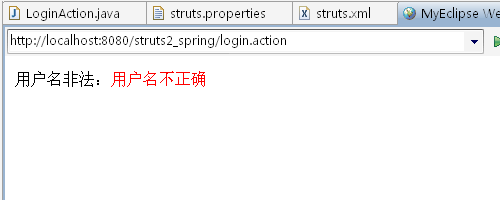- 浏览: 674956 次
- 性别:

- 来自: 北京
-

最新评论
-
mushiyu123:
...
iText官方教程 -
sf_dream:
楼主,你那个放到没有安装jdk的电脑上可以运行不?
eclipse导出jar文件再将它转换成exe可执行文件详解 -
zqb666kkk:
哥们 没图了 弄个附件 文档 供我们下载吧
PowerDesigner 使用教程(很具体,很实用) -
dhkswh:
楼主写的代码超级多错...不过总算看懂了,楼主是class.A ...
java swing 弹出对话框与父窗口传值实例


 <?xmlversion="1.0"encoding="UTF-8"?>
<?xmlversion="1.0"encoding="UTF-8"?> <%@pagelanguage="java"pageEncoding="GB2312"%>
<%@pagelanguage="java"pageEncoding="GB2312"%> pageEncoding="GB18030"%>
pageEncoding="GB18030"%> /*
/* *我们这只是一个小的例子,不与数据库打交到
*我们这只是一个小的例子,不与数据库打交到 */
*/





相关推荐
整合使用最新版本的三大框架(即Struts2、Spring4和Hibernate4),搭建项目架构原型。 项目架构原型:Struts2.3.16 + Spring4.1.1 + Hibernate4.3.6。 此外,还有:log4j、slf4j、junit4、ehcache等知识点。 项目...
精通Java EE:Eclipse Struts2 Hibernate Spring整合应用案例代码和数据库压缩包6
Struts2整合Spring Hibernate的CRUD实例Struts2整合Spring Hibernate的CRUD实例
Struts2 hibernate spring 整合案例
这是struts2.1.6 + hibernate3.1 + spring2.5的整合案例,使用注解,省去了配置xml的繁琐;
struts2+spring整合登陆验证经典完整案例!期余JAR文件在struts2+spring整合登陆验证经典完整案例!(JAR)这个中,免积分下载! 部署Web应用请按如下步骤进行: 1. 进入reg_login路径下,将mysql.sql脚本中的语句...
struts2 hibernate spring整合应用案例2
Struts2_Spring_Hibernate整合开发实例 同名视频的完整资料 超值
struts2、spring、ibatis整合实例 struts2、spring、ibatis整合实例 struts2、spring、ibatis整合实例 struts2、spring、ibatis整合实例
此例子包括struts2国际化、struts2验证、struts2拦截器、struts2整合spring、struts2+spring+hibernate整合而完成的登录例子。 下载后请先看readme文档。
struts2+spring+hibernate整合实例.rar struts2+spring+hibernate整合实例.rar
Struts 2+Spring 3+Hibernate框架技术精讲与整合案例2Struts 2+Spring 3+Hibernate框架技术精讲与整合案例2Struts 2+Spring 3+Hibernate框架技术精讲与整合案例2Struts 2+Spring 3+Hibernate框架技术精讲与整合案例2
struts2+spring+hibernate整合小案例,是一个很好的学习小DEMO
现在就将笔者使用Myeclipse工具应用struts2 + spring2 + hibernate3 实现CRUD操作的步骤一一纪录下来,为初学者少走弯路略尽绵薄之力!在本文中,笔者将Struts2.0.6、Spring2.0.6和Hibernate3.1进行整合,希望通过...
JavaEE Struts2整合Spring的小案例
ibatis+Spring+struts2整合实例
精通J2EE—Eclipse Struts Hibernate Spring 整合应用案例源代码和数据库,这是一部分。
整理不容易,如果觉得可以的话希望顶一下!
JAVA EE Eclipse struts hibernate spring 整合应用案例(第二版) 源代码 叶健毅著